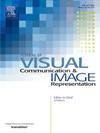DRGNet: Dual-Relation Graph Network for point cloud analysis
IF 2.6
4区 计算机科学
Q2 COMPUTER SCIENCE, INFORMATION SYSTEMS
Journal of Visual Communication and Image Representation
Pub Date : 2024-12-05
DOI:10.1016/j.jvcir.2024.104353
引用次数: 0
Abstract
Recently point cloud analysis has attracted more and more attention. However, it is a challenging task because point clouds are irregular, sparse, and unordered. To accomplish that task, this paper proposes Dual Relation Convolution (DRConv) which utilizes both geometric relations and feature-level relations to effectively aggregate discriminative features. The geometric relations take the explicit geometric structures to establish the spatial connections in the local regions while the implicit feature-level relations are taken to capture the neighboring points with the same semantic properties. Based on our proposed DRConv, we construct a Dual-Relation Graph Network (DRGNet) for point cloud analysis. To capture long-range contextual information, our DRGNet searches for neighboring points in both 3D geometric space and feature space to effectively aggregate local and distant information. Furthermore, we propose a Channel Attention Block (CAB), which puts more emphasis on important feature channels and effectively captures global information, and can further improve the performance of point cloud segmentation. Extensive experiments on object classification, shape part segmentation, normal estimation, and semantic segmentation tasks demonstrate that our proposed methods can achieve superior performance.
DRGNet:用于点云分析的双关系图网络
近年来,点云分析越来越受到人们的关注。然而,这是一项具有挑战性的任务,因为点云是不规则的、稀疏的和无序的。为了完成这一任务,本文提出了双重关系卷积(Dual Relation Convolution, DRConv)算法,该算法同时利用几何关系和特征级关系来有效地聚合判别特征。几何关系采用显式几何结构来建立局部区域的空间联系,而隐式特征级关系用于捕获具有相同语义属性的相邻点。基于我们提出的DRConv,我们构建了一个用于点云分析的双关系图网络(DRGNet)。为了捕获远程上下文信息,我们的DRGNet在三维几何空间和特征空间中搜索邻近点,以有效地聚合本地和远程信息。在此基础上,我们提出了一种通道注意块(Channel Attention Block, CAB)算法,该算法更加强调重要的特征通道,有效地捕获全局信息,进一步提高了点云分割的性能。在物体分类、形状部分分割、正态估计和语义分割任务上的大量实验表明,我们提出的方法可以取得优异的性能。
本文章由计算机程序翻译,如有差异,请以英文原文为准。
求助全文
约1分钟内获得全文
求助全文
来源期刊

Journal of Visual Communication and Image Representation
工程技术-计算机:软件工程
CiteScore
5.40
自引率
11.50%
发文量
188
审稿时长
9.9 months
期刊介绍:
The Journal of Visual Communication and Image Representation publishes papers on state-of-the-art visual communication and image representation, with emphasis on novel technologies and theoretical work in this multidisciplinary area of pure and applied research. The field of visual communication and image representation is considered in its broadest sense and covers both digital and analog aspects as well as processing and communication in biological visual systems.
 求助内容:
求助内容: 应助结果提醒方式:
应助结果提醒方式:


